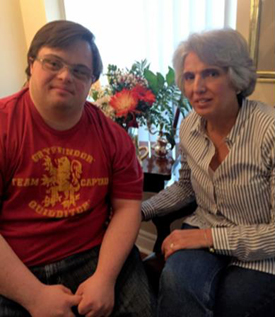Better continuity of primary care could lower emergency department visits for those with intellectual and developmental disabilities

By Ana Gajic

Julián (left) and Inés de Escallón
Inés de Escallón considers herself and her family lucky.
Her 31-year-old son, Julián, has Down syndrome. For much of his life, navigating the medical system has been easier for their family than for others Inés has talked to because he has a primary care team who knows him well. Julián has been seeing Dr. Bill Sullivan, a family physician at the St. Michael’s Hospital Academic Family Health Team for years.
“Not having to explain that Julián has an intellectual disability and that he might need more time with a physician is a relief,” Inés said. “Families can become overwhelmed – not with the disability, but with fighting for openness and support. Having the right team in place is very important.”
Published today, a new study from St. St. Michael’s Hospital and the Institute for Clinical Evaluative Sciences (ICES) quantifies the de Escallón family’s experience with continuous primary care. One in three adults with intellectual and developmental disabilities (IDD) visit the emergency department annually but effective primary care could reduce these numbers, the study suggests.
“For populations with IDD, the emergency department can be a frustrating and overwhelming place,” said Dr. Anna Durbin, scientist at the Li Ka Shing Knowledge Institute of St. Michael’s and lead author of the study. “Many people with IDD – about 88 per cent – are already accessing some form of primary care and it’s a great way to reach them. What can we do during these visits to prevent potentially difficult experiences in the emergency room?”
Diagnoses of IDD include Down syndrome, fetal alcohol spectrum disorder, autism and other pervasive developmental disorders, all presenting with adaptive behaviour deficits. Using administrative health databases combined with disability income support records, the research team studied the data of 66,464 adults aged 18-64 in Ontario with IDD, and compared the numbers to a random sample of about two million Ontarians without IDD. Researchers found that those with IDD were almost 1.5 times more likely to visit the emergency department. The study also found that the proportion of emergency department visits due to psychiatric issues was at least double for patients with IDD than for those without IDD.
Greater continuity of primary care, which means not only accessing services in the community but also continuing to see the same care provider from appointment to appointment, was associated with a lower probability of future emergency department visits. This was the case in both populations but the relationship was more pronounced in those with IDD.
For Dr. Sullivan, from the St. Michael’s Academic Family Health Team, these findings solidify what he has seen in front-line practice with patients with IDD. Though Dr. Sullivan has been involved in other studies about patients with IDD and the development of guidelines to improve their primary care, he was not involved this study.
“Patients with IDD may have trouble communicating and articulating their symptoms and their story to health-care providers,” he said. “Things that are fairly easy for us to diagnose because we know the patient can be difficult to sort out for staff in the emergency department who are unfamiliar with him or her. It’s important not only to have the same health team collaborating with patients, but also to focus on preventive care with them. That way, we can screen and address health issues and provide support before symptoms present or escalate to the point of needing emergency care.”
Though Dr. Sullivan and his team have made strides in the treatment of patients with IDD by developing comprehensive care guidelines, gaps still exist. These gaps are in part historical, and in part due to the nature of IDD, said Dr. Yona Lunsky, Senior Scientist at CAMH and senior author of this study.
“These are often invisible disabilities,” said Dr. Lunsky, who is also the director of the Health Care Access Research and Developmental Disabilities (H-CARDD) Program at CAMH. “It’s up to us in the health-care world to be willing to take the time to notice them and adjust our care accordingly.”
Based on her own positive experience with the St. Michael’s Family Health Team, Inés agrees.
“I would like to see more health-care teams that are interested in and trained for caring for people with IDD,” she said. “The smallest interactions with health care – how a diagnosis of a disability is delivered, how an issue is explained – stay with our families for life. We need people who understand that.”
About St. Michael’s Hospital
St. Michael’s Hospital provides compassionate care to all who enter its doors. The hospital also provides outstanding medical education to future health care professionals in more than 29 academic disciplines. Critical care and trauma, heart disease, neurosurgery, diabetes, cancer care, care of the homeless and global health are among the Hospital’s recognized areas of expertise. Through the Keenan Research Centre and the Li Ka Shing International Healthcare Education Centre, which make up the Li Ka Shing Knowledge Institute, research and education at St. Michael’s Hospital are recognized and make an impact around the world. Founded in 1892, the hospital is fully affiliated with the University of Toronto.
